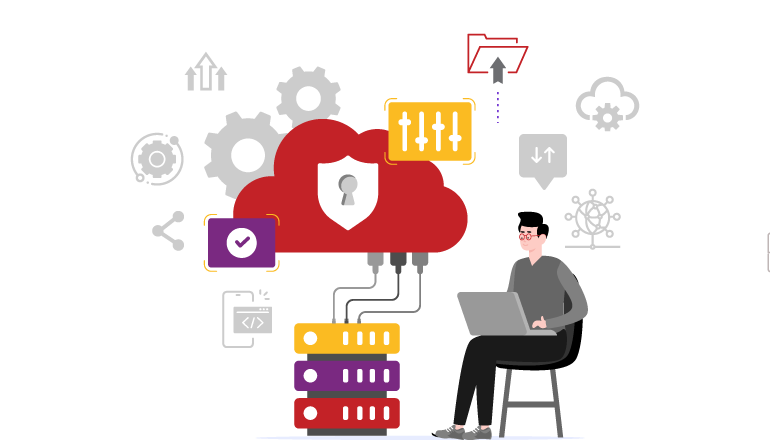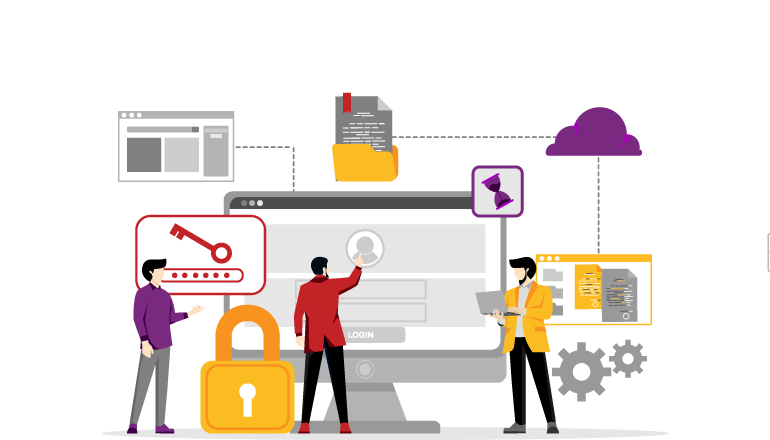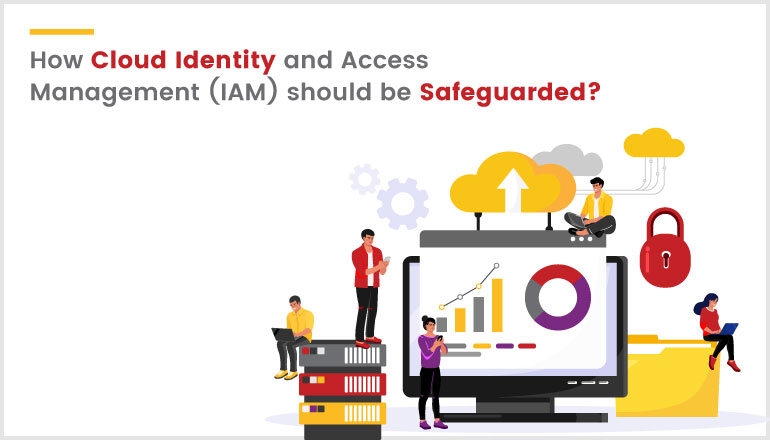Introduction
Cloud Environment offer virtual infrastructure for users to access services, applications, and data storage over the internet. It streamlines operations, reduces IT costs, and enhances security through built-in features like encryption and authentication. Scalability is a significant advantage, allowing rapid resource adjustments without hardware or software investments. Moreover, cloud environments empower organizations with agility, enabling quick product and service launches with minimal cost commitments.
Securing Cloud Access with IAM
Cloud Identity and Access Management (IAM) is a pivotal system for securely managing user access, identities, and permissions in cloud environments. IAM is instrumental in controlling resource access, safeguarding sensitive data, and adhering to data privacy regulations. A robust IAM solution incorporates multi-factor authentication, user access control, device authentication, encryption, and Role-based access control (RBAC). These technical measures not only protect digital assets but also enhance customer trust and productivity. Cloud IAM services encompass risk assessment, federated identity, secure device authentication, encryption for data security, and compliance solutions tailored to privacy regulations.
Risk Management and Auditing
Risk Management and Auditing are crucial elements of a successful Cloud IAM strategy. Risk assessment involves identifying potential risks related to user access, data security, and the cloud environment, focusing on encryption, device authentication, and security protocols. Risk management techniques are then used to minimize these risks and reduce potential threats.
Auditing user access is equally important, ensuring that users have access only to authorized resources. Audits should cover proper permissions, secure login methods like multi-factor authentication, strong password requirements, endpoint monitoring for suspicious activity, log file analysis, and compliance with privacy regulations and industry standards. These technical measures bolster cybersecurity while upholding transparency in data management.
Identity and Access Governance
Identity and access provisioning is the process of granting users access based on their roles, like administrators or regular users, determining what data and applications they can access. Identity and Access Governance (IAG) solutions help onboard new employees and ensure proper access levels for existing users. IT teams use these solutions to assign roles according to policies and maintain compliance with regulations.
Federated identity and single sign-on, used in IAG systems, simplify user authentication across various platforms. Federated identity lets users securely use one system's credentials to access another platform. Single sign-on further simplifies by allowing one set of login details across related websites, enhancing security through robust authentication procedures.
Role-Based Access Control (RBAC) adds a layer of control, ensuring that only authorized personnel access certain information or perform tasks. This enhances security by preventing unauthorized activity and malicious attacks. RBAC, when used with other IAG solutions, fortifies protection and regulatory compliance.

AWS IAM Tools
AWS Identity and Access Management (IAM) is a pivotal part of AWS security, allowing organizations to control access, manage user identities, and safeguard cloud resources. Key IAM terms include Access Key ID for authentication and Identity Federation to grant external sources access control. IAM involves managing users, groups, roles, policies, permissions, Multi-Factor Authentication (MFA), and resource identification using tags. AWS offers tools like CloudTrail for auditing, IAM Policy Simulator for policy evaluation, IAM Access Analyzer for permissions control, and Trusted Advisor for policy adherence. AWS Config helps monitor configurations, while Organizations centralizes policy management. AWS Security Hub provides a holistic view of security posture by aggregating insights from IAM and other services, enhancing data protection and access control.
AWS CloudTrail: AWS CloudTrail is a service that records API calls made on your AWS account. It can track and log actions performed by IAM users and roles. You can use CloudTrail logs to monitor and audit changes to your IAM policies and permissions.
AWS IAM Policy Simulator: The IAM Policy Simulator is a tool that allows you to test the effects of IAM policies before applying them. You can use it to evaluate the permissions of IAM users and roles to ensure they have the appropriate access.
IAM Access Analyzer: IAM Access Analyzer helps you identify and remove overly permissive access and resource-sharing across AWS accounts. It helps you ensure that your IAM policies are not granting unintended access.
AWS Trusted Advisor: Trusted Advisor provides security checks that include IAM best practices. It can identify and alert you about potential security concerns in your IAM configuration.
AWS Config: AWS Config allows you to monitor the configuration of your AWS resources, including IAM configurations. It provides a history of resource configuration changes, which can help you track and manage IAM-related changes over time.
AWS Organizations: AWS Organizations is a service that helps you centrally manage policies across multiple AWS accounts. You can use it to set policies and controls for IAM users and roles across your organization.
AWS Security Hub: AWS Security Hub provides a comprehensive view of your security posture in AWS. It aggregates and prioritizes security findings from multiple AWS services, including IAM-related findings.
Google Cloud IAM Tools
Google Cloud IAM (Identity and Access Management) provides a suite of tools and terms for managing user access and permissions within the Google Cloud Platform (GCP). Key tools include IAM itself for role-based access control, Cloud Identity for user management, Organization Policy Service for governance, Cloud Identity-Aware Proxy for secure access to web applications, and IAM Conditions for fine-grained policy control. Additionally, Cloud IAM Recommended employs machine learning to optimize access policies. Organizations can integrate with external identity providers for Single Sign-On (SSO). These tools collectively ensure secure and efficient management of access to GCP resources, helping organizations maintain strong security and compliance standards.
Google Cloud IAM: IAM is the core tool for controlling access to Google Cloud resources. It allows you to manage who has access, what actions they can perform, and on which resources.
Cloud Identity: Cloud Identity is a standalone identity management system provided by Google, which can also be integrated with GCP. It's mainly used for managing users and groups.
Organization Policy Service: This tool allows you to set policies and constraints at the organization level. It helps in governing how GCP resources are used and accessed within your organization.
Cloud Identity-Aware Proxy (IAP): IAP is a security tool that provides centralized and secure access control for web applications and resources. It verifies user identity and access before granting access to protected resources.
Cloud IAM Conditions: IAM Conditions allow you to create access policies based on various conditions, such as IP addresses, device attributes, time of day, and more.
Cloud IAM Recommended: This tool employs machine learning to analyze your organization's IAM policies. It provides recommendations to improve the security and efficiency of access controls.
External Identity Providers: You can integrate GCP with external identity providers (IdP) like Active Directory, Azure AD, or Okta. This enables Single Sign-On (SSO) and federated identity.
Secure Access Management
Multi-factor authentication (MFA) enhances security by requiring more than a username and password for access. Users must provide additional proof of identity, like a fingerprint scan or a one-time SMS code. This prevents unauthorized access to sensitive data and applications.
User Access Management (UAM) controls user permissions according to their role, bolstering security and regulatory compliance. UAM handles roles, passwords, user groups, credential resets, activity tracking, and administrative tasks for managing user accounts.
Device Authentication & Authorization adds security layers for remote access. It verifies device credentials before granting network access, preventing malware and ensuring secure networks. Authentication is often done with biometrics or pairing codes that must match predefined criteria for access approval.

Data Security & Compliance with Privacy Regulations
Data security is vital to safeguarding digital assets and adhering to data privacy regulations. A robust IAM solution offers rigorous security, including multi-factor authentication, user access control, encryption, and RBAC, boosting productivity and customer trust by protecting data from cyber threats.
Data loss prevention (DLP) detects suspicious data transfers, preventing potential breaches. Encryption masks data, ensuring only authorized personnel can access it, even in case of a successful attack.
Compliance solutions ensure adherence to privacy regulations like GDPR and CCPA, mitigating noncompliance risks and maintaining secure data handling in cloud environments.
Risks of Improperly Configured IAM in Cloud
When Cloud Identity and Access Management (IAM) is not implemented or configured properly, it opens the door to a host of security risks. Users may end up with excessive permissions, granting them access to data and resources they shouldn't have, leading to data breaches or unauthorized actions. Conversely, some users may be overly restricted, hindering their productivity. Misconfigurations could result in data exposure, where sensitive information is accessible to the wrong people. This can lead to regulatory compliance issues and potential legal repercussions. Inadequate IAM can also hamper incident response efforts, making it challenging to detect and respond to security breaches in a timely manner. Overall, a properly configured IAM system is essential for safeguarding user permissions and protecting an organization's digital assets from various security threats.
Capital One Data Breach (Real World Example)
In this cyberattack, a misconfigured web application firewall allowed an unauthorized user to access Capital One's cloud environment and pilfer sensitive customer data. The breach affected more than 100 million individuals. It underscores the significance of configuring IAM and security settings accurately within cloud infrastructures to prevent unauthorized access and data breaches. This incident highlights the potential consequences of IAM misconfigurations and serves as a cautionary tale for organizations in the digital age.
Securing IAM: Key Considerations
IAM is the guardian of your digital kingdom, but it must be fortified to withstand the ever-evolving threats in the digital realm. Here are the key aspects to secure within IAM
- Credentials Protection
- Access Control
- Encryption
- Device Authentication
- Auditing and Monitoring
- Compliance and Privacy
- Incident Response
Conclusion
A robust cloud Identity and Access Management (IAM) solution is vital for safeguarding digital assets and ensuring data privacy compliance. IAM grants secure access to sensitive data, employs multi-factor authentication, encryption, and role-based access control, limiting unauthorized access. Regular user account audits maintain proper permissions, promoting transparency and customer trust. Federated identity and single sign-on streamline account management, reducing the need for repetitive logins. A comprehensive IAM and security strategy not only protects against cyber threats but also ensures compliance with data privacy laws. This secures personal data, fostering productivity and client trust.


